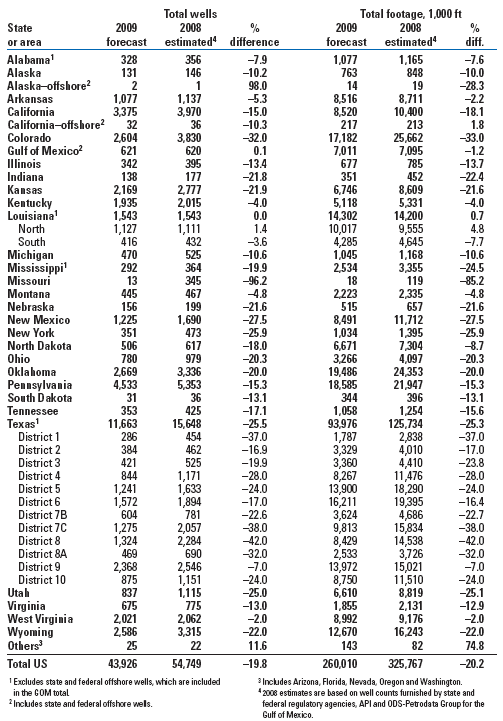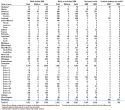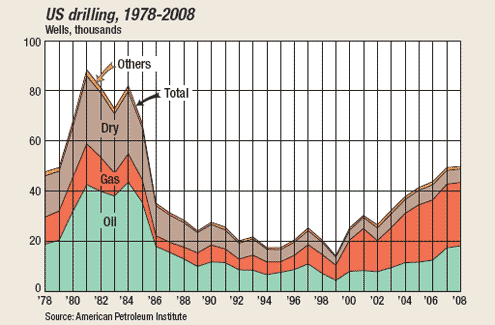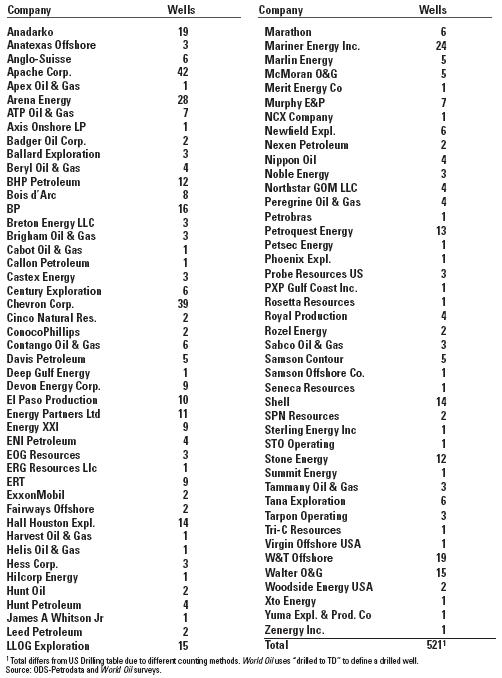Now that the boom has run its inevitable course and gone bust, we asked major and independent operators what they did in 2008, and what their plans were for 2009. Predicting activity levels depends on prices-that’s nothing new. But since our surveys took place over the late November–early January timeframe, the sharp drop in December rig counts means that operators’ estimates of 2009 activity depended on what week they responded. That fact, combined with the possibility that a deep, long recession, already more than a year old, could grow into a depression with double-digit unemployment, means that this is a true “crystal ball” forecast. The old Chinese proverb “May you live in interesting times” is both a blessing and a curse, and it best describes the situation our industry finds itself in today.
Majors were surprisingly pessimistic, indicating a 26% drop this year, while independents said they expected to drill “only” 12% fewer wells in 2009. For 2008, state agencies and other data showed that there were 54,749 wells drilled, which is 4.5% more than we predicted last February (52,394 wells), and less than our revised figure in August. Our forecast of a 20% drop is optimistic, depending largely on whether the deepening recession gets so bad that it strongly affects basic industries such as fertilizer and electricity production, thus curtailing natural gas demand.
Spending this year is expected to slow 26% in the US, according to Barclays Capital (see p. 45). This is in line with our survey of major drillers, even though Barclays had a large sampling of independents in its survey. Presumably, decreases in the cost of goods and services will let the money that does get spent stretch further.
World Oil’s forecast for 2009 shows:
- US drilling activity will decline to 43,926 wells
- US rig count will average 1,478 rigs, down 21% from 2008
- Canadian drilling will fall by about 7% from last year.
US prices. As we enter 2009, global oil inventories are rising, although still within normal ranges, while OPEC tries to restore higher prices through production cutbacks. The firm Groppe, Long & Littell forecast last year that the West Texas Intermediate (Cushing) oil price would average $70/bbl in 2008. In fact, it averaged $99.75. This year, the firm expects WTI to average $88.50, which assumes some discipline on the part of OPEC. They forecast gas prices to come down a bit, averaging $6.37/Mcf (Henry Hub), which implies about a dollar lower at the wellhead.
| Forecast of 2009 US wells and footage to be drilled |
 |
|
In our forecast, we initially assumed that oil drilling would be hurt more than gas drilling, since oil prices have come down the most; but that did not prove true. It depends on the geology, but even at $36/bbl for WTI crude, there may be less risk in drilling a Permian Basin oil well than there is drilling a $5/Mcf shale gas well.
US operators’ survey. World Oil’s survey of 10 US major drillers (integrated companies and independents with large drilling programs) and 120 independents received fewer returns than last year’s survey. Citing the current market climate and volatility, a large number of both US major and independent operators responded that they would not participate in this year’s survey, thus causing the overall number of wells forecast by US majors to drop sharply for both 2008 and 2009 when compared to last year’s numbers.
In 2009, major drillers continue to focus on developmental drilling, with only 4.8% of the wells designated as wildcats. Overall in 2009, the major drillers plan a 26% decrease in wells drilled.
Compared to the majors, US independents are forecasting a smaller drop, only 13%, in the number of wells to be drilled in 2009. They will continue to be more aggressive explorers than the major drillers and are planning 12.5% of their new wells as wildcat tests.
Onshore, the major drillers will focus wildcat drilling in Texas, while independents will continue their activities in Kansas first, then Texas. Offshore, both majors and independents plan to focus on Louisiana, with 16 and 8 wildcats, respectively. While the independents appear to be centralizing their wildcat efforts to only offshore Louisiana, the majors plan to branch out from Louisiana offshore wells in 2008 to wells in Louisiana, Florida and Texas this year. In our survey, majors and independents plan to drill a combined total of 8,559 wells in 2009, some 20% of the drilling forecast for 2009.
US rigs. Rig utilization will ride a downward slope in 2009, since more rigs came online in 2008. But demand is falling. A sharp dropoff was seen beginning in December and continuing into January with the rig count falling to 1,593 from 1,935 in November. The Baker Hughes rig count rose in 2008 by 6.2%, but for this year, we think that the rig count will fall to 1,478, a 400-rig, or 21%, decrease, with activity in the Gulf of Mexico holding steady as long-term deepwater projects continue.
What 10 US major drillers1 plan for 2009
Click table to enlarge. |
|

|
|
North Dakota saw the largest percent increase in rigs in 2008, running 74.4% more. Louisiana lost the most rigs in 2008 in the South and Offshore areas, losing nine and eight, respectively.
Drilling details. Since the US has more than 80% of rigs drilling for gas, that activity will have the greatest overall impact. There are more than a dozen shale gas plays in the US. The economics of each shale gas play is different, with various analysts giving break-even cost points in the $5.50−$7.50/Mcf range.
The Marcellus Shale play in Pennsylvania and the Fayetteville in Arkansas do not have long enough production histories for the public to know the precise economics, but in general these plays seem to be highly dependent on learning lessons quickly and finding the sweet spots; they are still attracting attention. In the Fayetteville, the largest operator, Southwestern Energy, will try to keep more than a dozen rigs active and hope for steady cash flow from their operations.
The Haynesville in north Louisiana may be in a class of its own, as it seems to have a substantial conventional aspect (nearby conventional reservoir rock), and might be able to withstand lower gas prices. Therefore, gas drilling will depend on the exact price of the day, which is below break-even (<$5/Mcf in late January) for nearly all of these plays as this goes to press.
What 120 US independents1 plan for 2009
Click table to enlarge |
|

|
|
Moreover, since investor cash inflows are presumably down with the stock market, and the availability and cost of higher-risk loans that are needed to fund this sort of drilling are not currently favorable, we would expect to see some companies simply put these plays on hold and pursue more conventional gas and oil deposits, assuming that they can. This could get painful.

Missouri is new to our table as a line item, as it usually drills so few wells that it is included in Others. However, in 2008, Canadian firm MegaWest Energy did a lot of drilling in southwestern Missouri as part of a heavy oil development project. The project was well along and producing oil in a SAGD operation, with expansion plans underway, when the price crash hit. As of January, the company had suspended operations, as the SAGD recovery operation was not economic with prices in the mid-$30s. Because of MegaWest’s change of plans, the state will see a return to lower drilling activity.
In the northwestern US, the Bakken Shale oil play will see moderating rig activity. Drilling will be off about 9% in North Dakota and about 5% in Montana.
Other unconventional gas plays will see activity fall while drilling economics are unfavorable. A case in point is the difference between Virginia and West Virginia. Virginia’s unconventional plays will see a 12% drop, while West Virginia’s largely conventional plays will moderate only 2%. Tennessee will see a 15% drop with opening plays in the Chattanooga and Conasauga Shales being postponed.
Texas will retain its activity lead by drilling the largest number of wells in the US during 2009. Although Permian Basin drilling will have the largest drop in wells (off 960 wells in District 8 from 2008 activity), Barnett Shale drilling in District 9 will moderate by only 7%. Overall the state will see a 25% reduction in drilling.
According to the Texas Alliance of Energy Producers, the Texas Petro Index has passed a peak. Economist Karr Ingham noted that in September, the index reached an all-time high of 282.3, from its 1995 reference base of 100. The index declined for the remainder of 2008, reaching 272.3 in December.
| Active Gulf of Mexico operators and wells drilled in 2008 |
 |
|
About these statistics. World Oil’s tables are produced with the aid of data from a variety of sources, including the American Petroleum Insititute, Groppe, Long & Littell, ODS-Petrodata Group, IHS Energy, the Texas Railroad Commission, other state and federal regulatory agencies, as well as international agencies. Most importantly, operating companies with drilling programs responded to this year’s survey. Please note credits and explanations in the table footnotes. We thank all contributors for their time and effort in providing data and analysis for this report.
World Oil editors try to be as objective as possible in the estimating process to present what they believe is the most current data available. It is realized that sound forecasting can only be as reliable as the base data. In this respect, it should be noted that well counting is a dynamic process and most historical data will be continually updated over a period of several years before “the books are closed” on any given year. 
|






